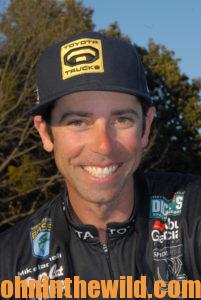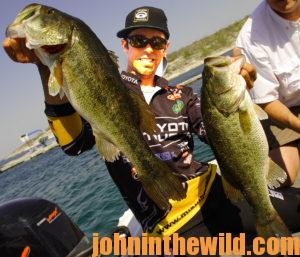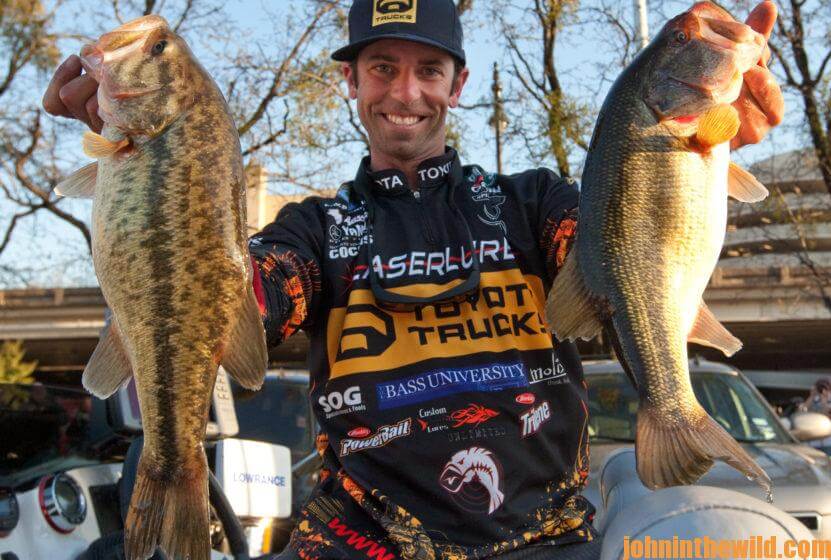Editor’s Note: Mike Iaconelli, 47 years old of Pittsgrove Township, New Jersey, is the only angler to have won the Bassmaster Classic, the title of Bassmaster Angler of the Year and the B.A.S.S. Nation Championship. He has total earnings of $3.1 million and is ranked the No. 44th bass fisherman in the world by BassFan.com (http://www.bassfan.com/). To learn more about Iaconelli, visit his Facebook Page at https://www.facebook.com/MikeIaconelliFishing/.
 There are many similarities and differences between tidal rivers and rivers that aren’t affected by the tide. The main difference is the fact that tidal rivers have water both going out of the river and water coming into the river. When the tide comes in, there’s an insurgence of salt water that pushes the fresh water back up the river. On an outgoing tide, the fresh water pushes the salt water back down the river. On most freshwater rivers, there’s a current coming, heading downriver at all times. Freshwater rivers only have a one-way current. Bass will position themselves on structures and feed whenever a current is running, regardless of the direction of the current.
There are many similarities and differences between tidal rivers and rivers that aren’t affected by the tide. The main difference is the fact that tidal rivers have water both going out of the river and water coming into the river. When the tide comes in, there’s an insurgence of salt water that pushes the fresh water back up the river. On an outgoing tide, the fresh water pushes the salt water back down the river. On most freshwater rivers, there’s a current coming, heading downriver at all times. Freshwater rivers only have a one-way current. Bass will position themselves on structures and feed whenever a current is running, regardless of the direction of the current.
Currents create eddies, backflows and eddy seams. All these different types of water are important to bass, regardless of river type. An eddy seam is the line between the swift-moving water and an object that creates a dead spot where there’s no current. Bass, whether they’re largemouth, smallmouth or spotted bass, are opportunistic feeders who prefer to hold on non-moving water but will remain on the edge of moving water to ride out the current and attack bait before moving to the dead spot in the water and waiting for more prey heading down the current. For instance, bass like to go to the end of a bluff and find a log that breaks the currents, or a rock that breaks the currents or pinpoint a high spot coming up 2-3 feet from the bottom that they can get behind. These eddy seams are spots that one can predict where bass will be seen. Too, the bass there should be easier to catch than bass in other places.
While professional and recreational bass anglers enjoy great electronics today, these eddy seams most likely will be found with your own eyes. I have some amazing sonar made by Lowrance
(https://www.lowrance.com/), including down-imaging, side-imaging, and forward-imaging, but most of the best current seams I pinpoint can be seen from my reading the water. I put my sunglasses on and search the bank for some type of structure coming off the bank that the current is hitting. Sometimes the current scene actually looks like a line that divides the swift water from the dead water. Many times, when the current hits structure like a log, a rock or a point with a dead spot behind that structure, that dead spot will be a back current on the back side of the eddy seam. This is the place where the current often turns backwards and makes a whirlpool 90 percent of the time. I find these types of places with my eyes, and I search for those kinds of areas, particularly on tidal rivers.
Another factor to be conscious of when fishing tidal rivers occurs whenever the tide is coming in, and all the bait fish and critters are following the water closer to the bank, into the grass and weeds. Oftentimes, the bass will be holding in that shallow water or on the first bottom break going into that shallow water. On a falling tide, the water in a current will start coming out of the grass and move into the bank structure that’s in shallow water. The bass will be there too, but they will be located further away from the bank than they’ve been when the tide’s coming in to shore.
 To learn more about bass fishing, check out John E. Phillips’ book, “How to Bass Fish Like a Pro” at http://amzn.to/YpoJvD, and available in Kindle, print and Audible versions.
To learn more about bass fishing, check out John E. Phillips’ book, “How to Bass Fish Like a Pro” at http://amzn.to/YpoJvD, and available in Kindle, print and Audible versions.
Tomorrow: Professional Bassers Greg Hackney and Edwin Evers on Fishing Tidal Rivers and Favorite Baits










